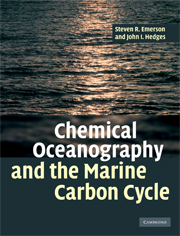Book contents
- Frontmatter
- Contents
- Preface
- Acknowledgements
- I Introduction to chemical oceanography
- II Advanced topics in marine geochemistry
- 8 Marine organic geochemistry
- 9 Molecular diffusion and reaction rates
- 10 Gases and air–water exchange
- 11 The global carbon cycle: interactions between the atmosphere and ocean
- 12 Chemical reactions in marine sediments
- Index
- Plate section
- References
9 - Molecular diffusion and reaction rates
Published online by Cambridge University Press: 05 September 2012
- Frontmatter
- Contents
- Preface
- Acknowledgements
- I Introduction to chemical oceanography
- II Advanced topics in marine geochemistry
- 8 Marine organic geochemistry
- 9 Molecular diffusion and reaction rates
- 10 Gases and air–water exchange
- 11 The global carbon cycle: interactions between the atmosphere and ocean
- 12 Chemical reactions in marine sediments
- Index
- Plate section
- References
Summary
Chemical kinetics is the study of the rate and mechanism of reaction. At ocean boundaries chemical fluxes are often determined by the interplay of molecular diffusion and reaction rates. Both of these topics are important to the chemical perspective of oceanography because they provide the necessary mechanistic and mathematical background for the study of chemical fluxes.
Labile chemical reactions near chemical equilibrium are a special case of kinetics, in which concentrations do not change with time, because the rates of the reactions producing and destroying a substance are equal. The study of chemical equilibrium is much more advanced than kinetics in its application to marine chemistry, because of the availability of thermodynamic state functions (e.g. free energies) for the calculation of equilibrium constants (Chapter 3). The added degree of complexity in the study of kinetics involves understanding the pathway and rate of approach to equilibrium. For example, it is much simpler to calculate the potential energy change of a boulder that once was part of a mountain peak and is now at rest in a river bed than it is to determine the pathway and speed of its fall.
Chemical thermodynamic models and increasingly sophisticated analytical measurements reveal the marine environment as a dynamic system that is rarely truly at equilibrium. Photosynthesis captures the energy from the sun and produces highly reduced organic molecules, forcing the Earth away from the state of equilibrium.
- Type
- Chapter
- Information
- Chemical Oceanography and the Marine Carbon Cycle , pp. 303 - 339Publisher: Cambridge University PressPrint publication year: 2008



